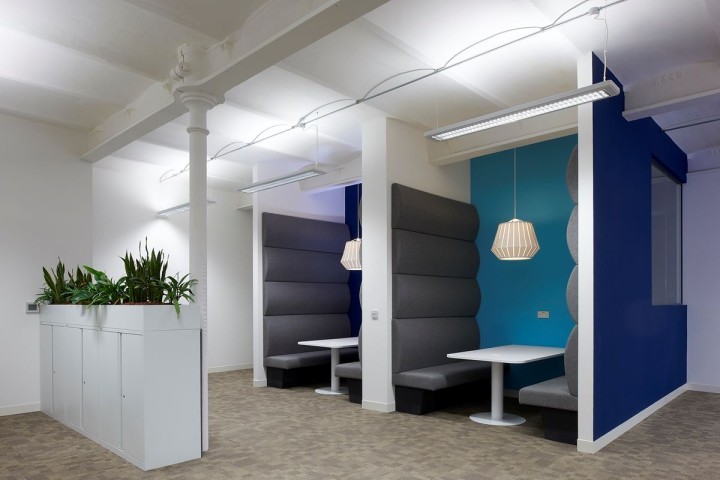Workplace sound specialists, Remark Group, recently reported that 65% of employees find that too much office noise effects their ability to work effectively, with almost half stating it has a negative effect on their wellbeing. These alarming figures highlight the importance of sound control measures within the workplace, with acoustics being the top of that list.
Coulter Office Interiors Managing Director, Stewart Simon, has seen the positive impact acoustic solutions can have on a whole range of office environments. Here, he explains why they are an effective and attractive fix.
Let’s get technical.
A well designed workplace will have acoustics at its core, with the aim of achieving that optimum sound level. According to some industry experts, this is between 30-40 decibels (dB), however many open plan offices reach highs of 70 dB – the equivalent of the noise made by a vacuum cleaner. This begs the question: What can be done to manage sound pollution at work?
The ‘ABC’ of acoustics details three general strategies: absorption, blocking and covering. Absorbing sound at the source is a popular option for busy offices, with acoustic panels, high backed furniture and suspended ceilings cited as key routes to success. Blocking noise can be achieved through the mass placement of screens, partitions and walls, which act as barriers between the sound source and work areas. The final option of covering noise involves wrapping hard surfaces, such as pillars or storage units, in soft fabrics to mask any unwanted disruptions.
But why is all of this necessary? Acoustic solutions bring a whole host of benefits to employers and employees:
1. A productive workforce
A recent survey by global floor manufacturer, Interface, revealed that noise negatively impacts 69% of the global workforce, impairing concentration levels, productivity and creativity. Good acoustics reduce distracting background noises, providing employees with the environment needed to complete their daily tasks comfortably and on time. Moreover, they aid communication between colleagues by absorbing unwanted echoes from other areas, leading to clearer conversations and increased privacy.
2. Happy and healthy employees
As mentioned, research suggests that excessive noise levels at work can have a detrimental impact on the physical and mental health of employees. One study by insurance company, Canada Life, reported that people who work in open-plan offices take a staggering 70% more sick days than those who don’t. According to the Remark Group, conversational distraction is the number one cause of employee dissatisfaction at work, while complete silence can also increase stress levels with many workers afraid to make noise. Acoustic solutions can help organisations achieve the right balance between a collaborative workplace and a distracting one, boosting employee wellbeing and morale.
3. Stylish finish
From an aesthetic point of view, acoustic solutions can also be used to make stylish additions to any office space. Available in a wide range of colours and designs, they span from vibrant panels and padded furniture to modern screens and ceiling grids. Coulter Office Interiors recently installed two acoustic meeting pods at IT Lab’s offices in Manchester, designed to act as “quiet zones” to hold informal meetings between colleagues. The seating, made with acoustic foam padding, was layered with grey wool upholstery, providing both excellent sound deadening qualities and an attractive finish that complemented the corporate colour scheme.
Acoustics are key.
As workplaces get busier and spaces more open, acoustics will become increasingly crucial to the wellbeing and productivity of your employees. Available in a variety of different designs, these solutions can be tailored to your requirements, providing you with an effective and attractive fix to your noisy workplace needs.
If you would like a free acoustics assessment, contact Coulter Office Interiors today on 01772 702555.
Enjoyed this? Read more from Coulter Office Interiors






















